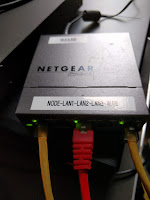 |
| Ubiquity Nanostation Loco M5 AREDN node |
At AA6E and ARRL, we have implemented a test network to learn about AREDN technology and to try out configurations that might support a variety of routine and emergency communications needs. The first setup uses up to 4 Ubiquiti NanoStation Loco M5 devices with custom AREDN software. These form a small-scale mesh, currently all within the ARRL Laboratory.
A test bed setup at AA6E uses two of these nodes to demonstrate network capabilities. Below is a block diagram of the tested network.
The AREDN network is at the right. One Loco M5 device supports a laptop computer (where I am writing this article). Through the radio link at 5.9 GHz, the two Locos support a bit stream of up to about 30 Mb/s using a 10 MHz RF channel. As seen by the laptop, the Loco provides an IP address through its own DHCP server. Traffic is routed to the second Loco, which in turn supports two VLANs (partitions of a single Ethernet connection). One is a generic "LAN" connection that will support Ethernet devices like the Raspberry Pi which is acting as a small webserver for our test. The Pi will also support SSH, VNC, and many other services as needed.
The second switch port supports another VLAN for "WAN" connections, e.g., to the Internet. Through the Internet router it obtains an address on the household LAN.
  |  |
L to R: Raspberry Pi 3; Netgear GS105E VLAN-aware switch; Toshiba Laptop
This setup demonstrates many of the functions we would need in an operational network. We still need to set up facilities for node to node bridging that we would need to build up a larger network, supporting multiple operating bands, etc.
There is nothing "new" here. It's all been done elsewhere, but we are climbing our learning curve.


No comments:
Post a Comment